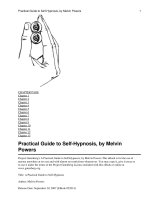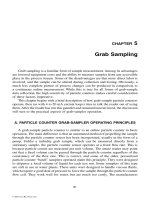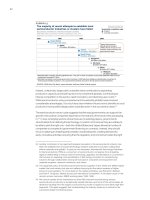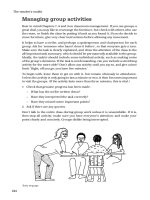Echocardiography A Practical Guide to Reporting - part 5 ppsx
Bạn đang xem bản rút gọn của tài liệu. Xem và tải ngay bản đầy đủ của tài liệu tại đây (691.44 KB, 16 trang )
Echocardiography: A Practical Guide for Reporting
54
Figure 5.7 Mitral prolapse. The posterior leaflet prolapses (a) and the regurgitant
jet is directed anteriorly (b), away from the abnormal leaflet
(a)
(b)
ch05 4/5/07 1:33 pm Page 54
• The duration of the jet using colour M-mode: Is it holosystolic or
present only in part of systole?
3. Continuous-wave signal
• Look at the shape and density of the signal. A signal as dense as
forward flow suggests severe regurgitation, a low intensity or incom-
plete signal mild regurgitation, and an intermediate signal moderate
regurgitation.
• Rapid depressurisation of the signal causes a ‘dagger-shaped’ signal,
and is a sign of severe regurgitation.
4. Pulsed Doppler
• A high transmitral E-wave velocity (>1.2 m/s) in the absence of mitral
stenosis suggests severe regurgitation.
19
• A pulsed sample in the pulmonary vein at a distance from the jet can
aid quantification, although this is most useful in TOE. Blunting of
Valve disease
55
Figure 5.8 Functional mitral regurgitation. In functional regurgitation, as a result of
symmetric tenting of the leaflets, the regurgitant jet is central; if one leaflet is slightly
more restricted than the other, the jet will be directed towards that leaflet
ch05 4/5/07 1:33 pm Page 55
Echocardiography: A Practical Guide for Reporting
56
Figure 5.9 Posterior leaflet restriction. In this patient with an inferoposterior
myocardial infarction, the posterior leaflet is restricted (a) and the regurgitant jet is
directed under the abnormal leaflet (b)
(a)
(b)
ch05 4/5/07 1:33 pm Page 56
the systolic signal occurs in moderate and severe regurgitation, and
flow reversal in very severe regurgitation.
5. Other methods of assessing degree of regurgitation
• A dilated LA is non-specific, but is usual with severe chronic regur-
gitation.
• A hyperdynamic LV strongly suggests severe regurgitation.
• Moderate pulmonary hypertension (systolic pressure up to 50 mmHg)
may complicate severe mitral regurgitation.
6. Grading regurgitation
• Make a judgement based on all modalities, with the specific signs in
Table 5.12 supported by the signal intensity and shape on continuous-
wave, LV activity, and pulmonary vein flow pattern.
7. LV function
• Measure the linear dimensions at the base of the heart and calculate the
fractional shortening. The systolic dimension is particularly important,
and should be averaged over several measurements. In the absence of a
regional wall-motion abnormality, a systolic dimension of 4.0 cm is a
threshold for surgery even with no symptoms.
• The LV shape may often change in severe mitral regurgitation, and
the LV systolic volume (biplane Simpson’s method) aids in the detec-
tion of progressive LV dilatation on serial studies.
• Severe regurgitation causes increased LV activity. Apparently normal
systolic function implies myocardial dysfunction. A fractional short-
ening <29%, LV ejection fraction <60%, or LV systolic diameter
>4.5 cm or end-systolic volume >90 ml/m
2
suggest a relatively low
chance of full LV recovery after surgery.
8. Mitral valve repair
• A checklist for suitability for repair before surgery is given in Table
5.13 and one for the assessment after surgery in Table 5.14.
• After repair, it is normal for the posterior leaflet to be echodense and
fixed. Most surgeons use an annuloplasty ring in most repairs (Figure
5.9).
Valve disease
57
ch05 4/5/07 1:33 pm Page 57
Echocardiography: A Practical Guide for Reporting
58
Table 5.14 Echocardiography after mitral valve repair
• Appearance of the mitral valve and annuloplasty ring
• Presence, localisation, and grade of residual regurgitation
• Presence and degree of stenosis
• Is there new systolic anterior motion of the anterior leaflet and LV
outflow acceleration?
• LV size and function
• RV size and function
• LA size
Checklist for reporting mitral regurgitation
1. Aetiology of mitral regurgitation
2. Detailed description of valve
3. Severity of regurgitation
4. LV dimensions and systolic function
5. PA pressure
6. Other valve disease
Table 5.13 Guide to suitability for repair
Usually repairable by a suitably experienced surgeon
• Posterior prolapse, especially affecting only the middle scallop (P2)
• Localised anterior prolapse
• Perforation
• Localised commissural prolapse
• Localised vegetation without valve destruction
• Mild tenting of the leaflets
• Mild restriction of the posterior leaflet
Repair difficult or impossible
• Widespread involvement of anterior and posterior leaflets
• Rheumatic disease
• Extensive destruction in endocarditis
• Severely restricted posterior leaflet with eccentric jet
• Severe tenting
• Dense annular calcification (debridement risks posterior LV rupture)
ch05 4/5/07 1:33 pm Page 58
TRICUSPID STENOSIS AND REGURGITATION
1. Is the valve morphologically normal?
• Rheumatic disease is easily missed, since the valve thickening is less
marked than on the left. Other causes of organic disease are given in
Table 5.15.
• Is there another cause for regurgitation, such as annular dilatation or
a pacing electrode?
2. Grading tricuspid regurgitation
See Table 5.16.
3. What is the estimated PA pressure?
See page 94.
Valve disease
59
Table 5.16 Grading tricuspid regurgitation
17
Mild Moderate Severe
Colour neck (mm) Usually none <7 >7
PISA radius (cm)
a
<0.5 0.6–0.9 >0.9
Jet area (cm
2
) <5 5–10 >10
Continuous-wave Incomplete Low or moderate Dense and may be
intensity triangular (Figure
5.10)
Hepatic vein flow Normal Maybe systolic Systolic reversal
blunting (Figure 5.11)
a
Colour scale limit 28 cm/s
Table 5.15 Causes of tricuspid valve disease
• Rheumatic disease (severe thickening uncommon)
• Myxomatous degeneration
• Endocarditis (intravenous drug abuser, Swan–Ganz catheter)
• Carcinoid
• Congenital e.g. Ebstein’s anomaly
• Amyloid (general thickening)
ch05 4/5/07 1:33 pm Page 59
Echocardiography: A Practical Guide for Reporting
60
Figure 5.10 Severe tricuspid regurgitation. Moderate or severe regurgitation
causes a large intra-atrial jet on colour mapping, with a dense continuous-wave signal
that retains its usual shape (a). In torrential regurgitation, the continuous-wave signal
(b) may be dagger-shaped.
(a)
(b)
ch05 4/5/07 1:33 pm Page 60
Valve disease
61
4. Is tricuspid stenosis present? (Figure 5.12)
• This is suggested by a V
max
>1 m/s and is likely if V
max
>1.5 m/s in the
absence of severe tricuspid regurgitation
20
or if the mean gradient is
>2 mmHg.
21
• The pressure half-time is prolonged in severe stenosis, but may vary
with respiration and is not reliable.
• Another clue is a small RV (because of underfilling) and a large RA
(because of high back-pressure).
PULMONARY STENOSIS AND REGURGITATION
1. Appearance of the valve
• Even in severe stenosis, there may be little thickening, but the valve
will be visible in systole as well as diastole.
• The most obvious clue is turbulent high-velocity flow during systole
on colour Doppler mapping.
Figure 5.11 Severe tricuspid regurgitation. Flow reversal in a hepatic vein.
ch05 4/5/07 1:33 pm Page 61
Echocardiography: A Practical Guide for Reporting
62
Figure 5.12 Tricuspid stenosis. Tricuspid stenosis may be missed because (unlike
the situation with the mitral valve) there is little thickening or calcification.
Figure 5.13 Pulmonary regurgitation. Mild regurgitation is shown on the left, with
a narrow jet originating at the valve level. Severe regurgitation on the right has a jet
filling the RV outflow tract with flow reversal as far as the right PA branch
ch05 4/5/07 1:33 pm Page 62
2. Is pulmonary regurgitation present?
Severe regurgitation is suggested by the following:
22
• a wide color jet (e.g., >7.5 mm or filling the RV outflow tract)
• diastolic flow reversal visible in the distal main PA (Figure 5.13)
• a steep dense signal (pressure half-time <100 ms)
• active dilated RV.
3. What is the pressure difference across the valve?
Severe stenosis is suggested by the following:
2,23
• transpulmonary V
max
>4 m/s
• mean pressure difference >50 mmHg
• mean pressure difference <50 mmHg with RV dysfunction.
4. What is the pulmonary artery pressure? See page 94
• Dominant pulmonary regurgitation may be caused by pulmonary
hypertension.
• Pulmonary stenosis tends to protect the pulmonary circulation against
the effect of high flow from a left-to-right shunt.
REFERENCES
1. Kennedy KD, Nishimura RA, Holmes DR Jr, Bailey KR. Natural history of moderate
aortic stenosis. J Am Coll Cardiol 1991; 17:313–19.
2. Bonow RO et al. ACC/AHA 2006 guidelines for the management of patients with
valvular heart disease: a report of the American College of Cardiology/American Heart
Association Task Force on Practice Guidelines. J Am Coll Cardiol 2006; 48:e1–148.
3. Monin JL, Quere JP, Monchi M, et al. Low-gradient aortic stenosis: operative risk strat-
ification and predictors for long-term outcome: a multicenter study using dobutamine
stress hemodynamics. Circulation 2003; 108:319–24.
4. Chambers J. Low ‘gradient’, low flow aortic stenosis. Heart 2006; 92:554–8.
5. Nishimura RA, Grantham JA, Connolly HM, et al. Low-output, low-gradient aortic
stenosis in patients with depressed left ventricular systolic function: the clinical utility
of the dobutamine challenge in the catheterization laboratory. Circulation 2002;
106:809–13.
6. Iung B, Gohlke-Barwolf C, Tornos P, Tribouilloy C, et al. Recommendations on the
management of the asymptomatic patient with valvular heart disease. Eur Heart J 2002;
23:1252–66.
7. Dujardin KS, Enriquez-Sarano M, Schaff HV, et al. Mortality and morbidity of aortic
regurgitation in clinical practice. A long-term follow-up study. Circulation 1999;
99:1851–7.
8. Perry GJ, Helmcke F, Nanda NC, Byard C, Soto B. Evaluation of aortic insufficiency
by Doppler color flow mapping. J Am Coll Cardiol 1987; 9:952–9.
9. Teague SM, Heinsimer JA, Anderson JL, et al. Quantification of aortic regurgitation
utilizing continuous wave Doppler ultrasound. J Am Coll Cardiol 1986; 8:592–9.
Valve disease
63
ch05 4/5/07 1:33 pm Page 63
10. Samstad SO, Hegrenaes L, Skjaerpe T, Hatle L. Half time of the diastolic aortoven-
tricular pressure difference by continuous wave Doppler ultrasound: a measure of the
severity of aortic regurgitation? Br Heart J 1989; 61:336–43.
11. Willett DL, Hall SA, Jessen ME, Wait MA, Grayburn PA. Assessment of aortic regur-
gitation by transesophageal color Doppler imaging of the vena contracta: validation
against an intraoperative aortic flow probe. J Am Coll Cardiol 2001; 37:1450–5.
12. Tribouilloy C, Avinee P, Shen WF, et al. End diastolic flow velocity just beneath the
aortic isthmus assessed by pulsed Doppler echocardiography: a new predictor of the
aortic regurgitant fraction. Br Heart J 1991; 65:37–40.
13. Bonow RO, Carabello B, de LA Jr, et al. Guidelines for the management of patients
with valvular heart disease: executive summary. A report of the American College of
Cardiology/American Heart Association Task Force on Practice Guidelines (Committee
on Management of Patients with Valvular Heart Disease). Circulation 1998;
98:1949–84.
14. Reid CL, Otto CM, Davis KB, et al. Influence of mitral valve morphology on mitral
balloon commissurotomy: immediate and six-month results from the NHLBI Balloon
Valvuloplasty Registry. Am Heart J 1992; 124:657–65.
15. Fawzy ME, Hegazy H, Shoukri M, et al. Long-term clinical and echocardiographic
results after successful mitral balloon valvotomy and predictors of long-term outcome.
Eur Heart J 2005; 26:1647–52.
16. Wilkins GT, Weyman AE, Abascal VM, Block PC, Palacios IF. Percutaneous balloon
dilatation of the mitral valve: an analysis of echocardiographic variables related to
outcome and the mechanism of dilatation. Br Heart J 1988; 60:299–308.
17. Zoghbi WA, Enriquez-Sarano M, Foster E, et al. Recommendations for evaluation of
the severity of native valvular regurgitation with two-dimensional and Doppler echo-
cardiography. J Am Soc Echocardiogr 2003; 16:777–802.
18. Spain MG, Smith MD, Grayburn PA, Harlamert EA, DeMaria AN. Quantitative assess-
ment of mitral regurgitation by Doppler color flow imaging: angiographic and hemody-
namic correlations. J Am Coll Cardiol 1989; 13:585–90.
19. Thomas L, Foster E, Schiller NB. Peak mitral inflow velocity predicts mitral regurgita-
tion severity. J Am Coll Cardiol 1998; 31:174–9.
20. Parris TM, Panidis JP, Ross J, Mintz GS. Doppler echocardiographic findings in
rheumatic tricuspid stenosis. Am J Cardiol 1987; 60:1414–16.
21. Ribeiro PA, Al Zaibag M, Al Kasab S, et al. Provocation and amplification of the
transvalvular pressure gradient in rheumatic tricuspid stenosis. Am J Cardiol 1988;
61:1307–11.
22. Rodriguez RJ, Riggs TW. Physiologic peripheral pulmonic stenosis in infancy. Am J
Cardiol 1990; 66:1478–81.
23. Silvilairat S, Cabalka AK, Cetta F, Hagler DJ, O’Leary PW. Echocardiographic assess-
ment of isolated pulmonary valve stenosis: Which outpatient Doppler gradient has the
most clinical validity? J Am Soc Echocardiogr 2005; 18:1137–42.
Echocardiography: A Practical Guide for Reporting
64
ch05 4/5/07 1:33 pm Page 64
6
PROSTHETIC VALVES
GENERAL
• All prosthetic valves are obstructive compared with a normal native
valve, and it is important to differentiate normal from pathologic
obstruction.
• Minor regurgitation through the valve is usually normal, and the
pattern differs between the types.
1. Appearance of the valve
• Note the position and type (Figure 6.1 and Table 6.1).
Table 6.1 Types of replacement heart valve (see also Appendix 2)
Biological
Stented xenograft
• Porcine
• Pericardial
Stentless
• Autograft
• Homograft
• Porcine xenograft
• Pericardial xenograft
Mechanical
• Caged-ball
• Tilting disc
• Bileaflet
ch06 4/5/07 1:33 pm Page 65
Echocardiography: A Practical Guide for Reporting
66
• Does the prosthesis rock? In the aortic position, this is always caused
by a large dehiscence (usually >30% of the sewing ring). In the mitral
position, it may be as a result of conservation of the native leaflets.
If the valve is biological
• Are the cusps thickened (>3 mm in thickness)?
• Is cusp motion normal, or is there decreased motion (suggesting
obstruction) or increased motion (suggesting a tear). Increased motion
can either be due to prolapse or a flail cusp or segment (moving
through 180°).
• Newly implanted (up to 6 months) stentless valves may be associated
with a thickened aortic root caused by oedema and haematoma.
Figure 6.1 Echocardiograms of prosthetic heart valves. (a) Stented porcine aortic
xenograft in a parasternal short-axis view. (b) Caged-ball mitral valve in a 4-chamber
view. (c) Tilting-disk aortic valve in a parasternal long-axis view. (d) Zoomed view of
a bileaflet mechanical mitral valve in a 4-chamber view
(a) (b)
(c) (d)
ch06 4/5/07 1:33 pm Page 66
Occasionally, this may be mistaken for an abscess on transoe-
sophageal echocardiography.
• Is there a separate echogenic mass (either vegetation or torn cusp).
If the valve is mechanical
• Does the occluder (disk or ball or leaflets) open quickly and fully?
• If there are two leaflets, does each open and close symmetrically?
– Minor variation in closing time may occasionally be seen in a
mitral valve.
– Fluttering of the leaflets of a bileaflet valve is normal.
• Is there a separate echogenic mass attached to the valve?
– Consider thrombus or a vegetation.
– If thin, it could be a fibrin strand, which is normal.
• Dense spontaneous echoes in the LV cavity are normal in replacement
mitral mechanical valves.
2. Is there regurgitation or evidence of obstruction?
• Interpretation depends on the position of the valve (pages 67–73).
3. LV and RV function and PA pressure
• A hyperdynamic LV is a clue that there is severe prosthetic aortic or
mitral regurgitation. A hyperdynamic RV suggests severe right-sided
prosthetic regurgitation.
• A rise in PA pressure can be a sign of prosthetic mitral valve obstruc-
tion.
4. When is TOE needed? (Table 6.2)
• TTE and TOE are complementary and TOE is rarely used without
initial TTE. Although the transoesophageal approach is usually neces-
sary to image vegetations and posterior root abscesses, anterior root
abscesses may be better seen on TTE.
AORTIC POSITION
1. Is there any regurgitation?
• How many jets and where are they?
– The site of an aortic jet can be described on the sewing ring as a
clockface in the parasternal short-axis view.
Prosthetic valves
67
ch06 4/5/07 1:33 pm Page 67
• Is the regurgitation through the valve, paraprosthetic, or both?
Localisation can only be certain if:
– the base or neck of the jet can be imaged in relation to the sewing
ring (Figure 6.2) or
– for a mechanical valve, the study matches the typical pattern of
normal regurgitation (Figure 6.3)
• Regurgitation through the valve in bileaflet mechanical valves (‘pivotal
washing jets’) begins close to the edge of the orifice and must not be
mistaken for paraprosthetic jets.
• Is it normal or abnormal?
– Mild regurgitation is commonly seen through biological valves and
is usually normal. However, when associated with a thickened
cusp, it is an early sign of primary failure – especially if it increases
on serial studies.
– Normal regurgitation through a mechanical valve is usually low in
momentum (relatively homogeneous colour), with an incomplete or
very low-intensity continuous-wave signal.
2. Severity of regurgitation
• Use the same methods as for native regurgitation (see page 46).
Assessing the height of a jet relative to LV outflow diameter may be
difficult, since paraprosthetic jets are often eccentric.
• The circumference of the sewing ring occupied by the aortic jet is
another guide: mild (<10%), moderate (10–20%), severe (>20%).
Echocardiography: A Practical Guide for Reporting
68
Table 6.2 Indications for TOE
• Endocarditis at least a moderate possibility
• Obstruction of a mechanical valve to determine the cause (Table 6.3)
• Obstruction not certain (equivocal EOA and cusp or occluder poorly
imaged transthoracically)
• Abnormal regurgitation suspected, but transthoracic study normal or
equivocal:
– Breathless patient
– Hyperdynamic LV
– Haemolysis
• Mitral regurgitant jet of uncertain size
• Thromboembolism despite adequate anticoagulation (look for pannus or
thrombus)
ch06 4/5/07 1:33 pm Page 68
Prosthetic valves
69
Table 6.3 Causes of obstruction in a mechanical valve
• Thrombosis
• Pannus
• Vegetations
• Mechanical (e.g. chord, septal bulge)
Figure 6.2 Paraprosthetic regurgitation. Parasternal long-axis view of a bileaflet
mechanical aortic valve. There is a jet originating in the aorta, with the neck clearly
imaged outside the sewing ring and directed eccentrically in the LV outflow tract
3. Is there evidence of obstruction? (Table 6.4)
• In biological valves, this is shown by thickened and immobile cusps.
The disk or leaflets of an obstructed mechanical valve may be diffi-
cult to image even on TOE, but obstruction in mechanical valves in
the aortic position is rare.
• Measure V
max
and peak and mean gradient, and EOA using the classi-
cal form of the continuity equation. Compare with normal values for
type and size (Appendix 2).
ch06 4/5/07 1:33 pm Page 69









